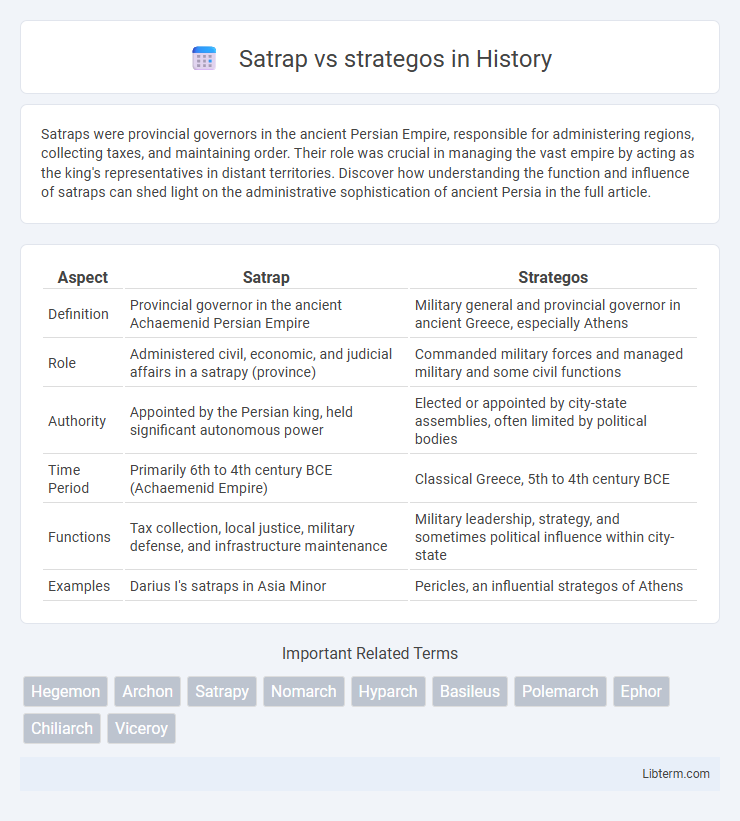Satraps were provincial governors in the ancient Persian Empire, responsible for administering regions, collecting taxes, and maintaining order. Their role was crucial in managing the vast empire by acting as the king's representatives in distant territories. Discover how understanding the function and influence of satraps can shed light on the administrative sophistication of ancient Persia in the full article.
Table of Comparison
| Aspect | Satrap | Strategos |
|---|---|---|
| Definition | Provincial governor in the ancient Achaemenid Persian Empire | Military general and provincial governor in ancient Greece, especially Athens |
| Role | Administered civil, economic, and judicial affairs in a satrapy (province) | Commanded military forces and managed military and some civil functions |
| Authority | Appointed by the Persian king, held significant autonomous power | Elected or appointed by city-state assemblies, often limited by political bodies |
| Time Period | Primarily 6th to 4th century BCE (Achaemenid Empire) | Classical Greece, 5th to 4th century BCE |
| Functions | Tax collection, local justice, military defense, and infrastructure maintenance | Military leadership, strategy, and sometimes political influence within city-state |
| Examples | Darius I's satraps in Asia Minor | Pericles, an influential strategos of Athens |
Introduction to Satraps and Strategoi
Satraps served as provincial governors in the ancient Persian Empire, overseeing administrative, military, and fiscal responsibilities to maintain imperial control across vast territories. Strategoi were military generals in ancient Greece, particularly in city-states like Athens, who commanded armies and managed defense strategies during warfare. Both positions held significant power, but satraps combined civil governance with military oversight, whereas strategoi specialized primarily in military leadership.
Historical Origins of the Satrap and Strategos
The satrap originated in the Achaemenid Empire as a provincial governor overseeing administrative and military functions, established by Cyrus the Great in the 6th century BCE to maintain centralized control over vast territories. The strategos emerged in ancient Greece, particularly in Athens during the 5th century BCE, as a military general responsible for commanding armies and naval forces, reflecting the city-state's emphasis on military leadership and democracy. Both roles illustrate the evolution of regional governance and military command in distinct political and cultural contexts of the ancient Near East and Classical Greece.
Geographic Domains: Persian Empire vs. Greek City-States
Satraps governed extensive provinces within the Persian Empire, overseeing diverse and large geographic domains that spanned across multiple regions of modern-day Iran, Mesopotamia, Egypt, and parts of Asia Minor. Greek strategoi operated within much smaller geographic units, typically individual city-states such as Athens or Sparta, where their authority was limited to local military and political affairs. The scale of satrapal authority reflected the centralized but vast nature of the Persian administrative system, contrasting with the more localized and fragmented control exercised by strategoi in the highly autonomous Greek polis system.
Roles and Responsibilities of a Satrap
A Satrap was a provincial governor in the ancient Persian Empire responsible for administration, tax collection, and maintaining local order within their satrapy. They acted as the king's representative, ensuring loyalty by managing military forces, overseeing justice, and supervising local officials. Unlike a strategos, who was primarily a military commander in Greek city-states, the Satrap's role combined civil governance with regional military oversight.
Duties and Powers of a Strategos
A strategos in ancient Greece held military command and administrative authority, responsible for leading armies, organizing defenses, and implementing state policies in their region. Unlike the satrap, whose role was primarily provincial governance under the Persian Empire, the strategos exercised direct control over both military operations and civil affairs within the city-state. Their duties encompassed mobilizing troops, managing logistics, and enforcing laws, positioning them as key figures in maintaining security and political stability.
Appointment and Authority: Hereditary vs. Elected
Satraps were typically appointed by Persian kings and often held their positions hereditary, ensuring continuity within ruling families in the Achaemenid Empire. In contrast, strategoi were generally elected or appointed based on merit and military prowess in ancient Greek city-states, reflecting a more dynamic and performance-based authority. The hereditary nature of satraps granted them long-term regional control, while strategoi faced periodic accountability to their polis or assemblies.
Military Command: Satrap vs. Strategos
Satraps, ancient Persian provincial governors, wielded both administrative power and military command, overseeing local armies to maintain regional control and suppress rebellions. Strategos, in Classical Greece, referred specifically to elected or appointed military generals responsible for leading city-state armies during campaigns and battles. While satraps combined civil governance with military authority, strategoi primarily focused on strategic military leadership and tactical operations.
Administrative Functions and Governance Styles
Satraps, as provincial governors in the Achaemenid Empire, held wide-ranging administrative functions including tax collection, local law enforcement, and maintaining regional security under centralized imperial authority. Strategoi, commonly found in Greek city-states and Hellenistic kingdoms, combined military leadership with civic governance, often overseeing local administration and commanding armies during wartime. The governance style of satraps emphasized hierarchical control and loyalty to the emperor, while strategoi embodied a more integrative approach balancing civilian administration with military responsibilities.
Notable Satraps and Famous Strategoi
Satraps like Darius I governed vast regions of the Persian Empire, exemplifying centralized royal authority, while notable strategoi such as Alexander the Great commanded military campaigns that expanded Macedonian influence across Asia. The satrap system facilitated efficient provincial administration under Persian rule, with officials like Artaxerxes I maintaining order and collecting tribute. Famous strategoi including Pericles shaped Athenian democracy and naval dominance, highlighting the military and political significance of this leadership role in ancient Greece.
Legacy and Influence on Modern Governance
Satraps, appointed as provincial governors in the Achaemenid Empire, established early models of decentralized administration that influenced subsequent imperial governance structures. Strategos, the military generals and regional administrators in ancient Greece, integrated military authority with civic leadership, setting precedents for combining civil and military powers in governance. The legacies of both satraps and strategoi resonate in modern federal systems and military governance frameworks, highlighting enduring principles of regional autonomy and centralized oversight.
Satrap Infographic

 libterm.com
libterm.com